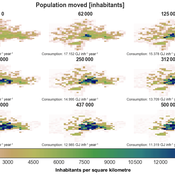
Roger Cremades
Affiliations Personal homepagehttps://bsky.app/profile/rogercre.bsky.social
Professional homepagehttps://environment.leeds.ac.uk/see/staff/13034/roger-cremades
ORCID more infohttps://orcid.org/0000-0002-4514-2462
GitHub more info
Dr. Roger Cremades is a complex systems scientist and heterodox global change economist integrating human-Earth interactions across systems and scales into modular quantitative tools, e.g. connecting drought risks in cities with land use at the river basin scale. He is elected Council member of the Complex Systems Society (2022-2025) and previously served as co-Chair of the Development Team of the Finance and Economics Knowledge-Action Network of Future Earth, the largest global research programme in global change (2020-2022). Roger coordinated research and co-production projects above €1M, and published in top journal like PNAS, Nature Climate Change, and Nature Geoscience. As a scientific modeler in the Social and Ecological Sciences, Roger integrates complex systems concepts into integrated assessment models of global change, with a focus on cities.
The future of CoMSES.Net, in Roger’s vision, is to augment its projection into a hub for discussing state-of-the-art approaches on modeling for the Social and Ecological Sciences, e.g. via bi-annual webinars, so that the Model Library becomes a lighthouse from where all communities developing, sharing, using, and reusing agent-based and other computational models also find valuable discussions to advance their research, education, and computational practice.
Research Interests
Global change, human-Earth interactions, complex systems.
The Urban Drought Nexus Tool
Roger Cremades Muhamad Khairulbahri | Published Thursday, December 14, 2023The “Urban Drought Nexus Tool” is a system dynamics model, aiming to facilitate the co-development of climate services for cities under increasing droughts. The tool integrates multiple types of information and still can be applied to other case studies with minimal adjustments on the parameters of land use, water consumption and energy use in the water sector. The tool needs hydrological projections under climate scenarios to evaluate climatic futures, and requires the co-creation of socio-economic future scenarios with local stakeholders. Thus it is possible to provide specific information about droughts taking into account future water availability and future water consumption. Ultimately, such complex system as formed by the water-energy-land nexus can be reduced to single variables of interest, e.g. the number of events with no water available in the future and their length, so that the complexities are reduced and the results can be conveyed to society in an understandable way, including the communication of uncertainties. The tool and an explanatory guide in pdf format are included. Planned further developments include calibrating the system dynamics model with the social dynamics behind each flow with agent-based models.
IUCM - The Integrated Urban Complexity Model
Roger Cremades Philipp S. Sommer | Published Thursday, December 14, 2023We present the Integrated Urban Complexity model (IUCm 1.0) that computes “climate-smart urban forms”, which are able to cut emissions related to energy consumption from urban mobility in half. Furthermore, we show the complex features that go beyond the normal debates about urban sprawl vs. compactness. Our results show how to reinforce fractal hierarchies and population density clusters within climate risk constraints to significantly decrease the energy consumption of urban mobility. The new model that we present aims to produce new advice about how cities can combat climate change. From a technical angle, this model is a geographical automaton, conceptually interfacing between cellular automata and spatial explicit optimisation to achieve normative sustainability goals related to low energy. See a complete user guide at https://iucm.readthedocs.io/en/latest/ .
Under development.
